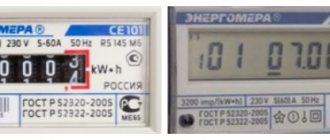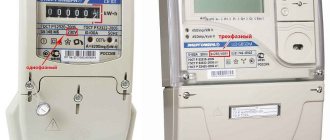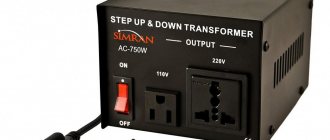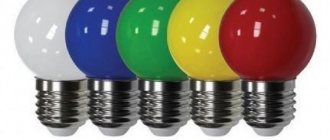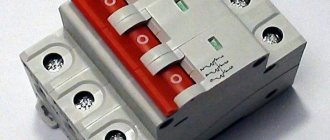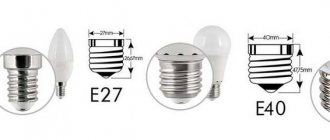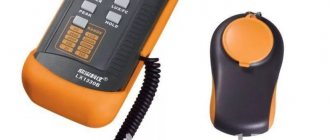How to properly seal an electricity meter, and who should do it
Sealing of meters is confirmation of the mechanical integrity, serviceability and functionality of the metering device.
This process is a protective function to eliminate the possibility of unauthorized entry to take electrical energy from the supply network. Sealing of electricity meters is considered a mandatory process; each working electricity meter is required to have a seal from the service provider. Today there are two different types of fillings:
- sealing by the meter manufacturer;
- seal from the service provider.
A seal from the manufacturer can confirm the functionality of the electricity meter for mechanical integrity, taking into account compliance with the declared characteristics and metering accuracy. In addition, the sealing of the electricity meter indicates that tests have been carried out, which is confirmed by the passport of the meter itself.
Another type of sealing is carried out during commissioning by energy sales employees when installing and placing an electric meter on the balance sheet of the service provider. Representatives of the inspection service are required to seal the electricity metering device before putting the electrical energy metering unit into operation.
How to choose an electricity meter
For personal use and industrial use, we recommend purchasing an electricity meter with accuracy class 2 or 1.
The electricity meter is entered into the State Register. The equipment must have a seal of the public service verifier, which bears the stamp and the date when the verification was carried out.
When purchasing a meter, the seller must provide documents for the product, which indicate the production date, the accuracy class of the meter and the date of verification.
Electric meters can be put into operation if the following has passed since their release:
- no more than 2 years for single-phase electricity meters.
- no more than one year for three-phase electricity meters.
If more time has passed since the purchase than prescribed by government regulations, then such a device must be submitted to special organizations for verification. Upon completion of the verification work, the client is given a certificate and sealing is performed. The certificate has a validity period, as for factory products.
How to seal an electricity meter
Seals on metering devices should be carried out free of charge by the executive bodies of the service provider if this is the first installation of an electric meter.
A fee may apply if the meter is resealed. This issue is regulated by relevant draft laws.
Paragraph 8 of Resolution No. 442 states that there is no payment for services for sealing a unit being put into operation or for other means of visual monitoring of the integrity of the product.
Resolution number 354, paragraph 81, paragraphs 8, 9, 14 says:
- sealing must be performed immediately before signing the commissioning at the expense of the executive body;
- the cost of launching electricity meters is paid by the service provider;
- the consumer is obliged to pay for re-sealing and pay for repair work in case of damage to the electricity meter;
- Electric meter verification services are not paid for.
An electric energy meter can be sealed for the following reasons:
- initial launch of the product;
- transfer, replacement or restoration of a faulty electricity meter.
What to do if the seal on the electric meter is broken
Whatever one may say, absolutely everything can be damaged, and the electricity meter is no exception. If the seal on the meters is damaged, you should:
- first of all, record the date of discovery and photograph the damage;
- immediately notify the management organization of the identified problem;
- write a statement of damage in two copies and leave one of them with the sales organization, and on the other get a stamp or signature with the date the statement was accepted.
The fact that the seal is broken or damaged cannot lead to serious consequences, in particular if the meter itself is located outside the apartment, but it is worth remembering that power engineers are highly suspicious of such cases and suspect the owner of trying to steal some electricity. It is for this reason that it is better to identify damage to the seal to the owner of the apartment, and not to the power engineers during a routine routine inspection of the energy system.
Requirements for sealing meters in the regulations of the Russian Federation
The legislative acts of the Russian Federation contain provisions that all energy metering devices must be checked and sealed after installation. This is a necessary measure to prevent unauthorized access to the internal elements of devices. The law also stipulates that meters that have not passed the sealing procedure are not allowed to register. This means they cannot be used for their intended purpose.
Access control devices must be installed by utility companies. The service is free and mandatory. Charging a fee for sealing a meter is considered an administrative violation. For this, management companies are fined up to 20,000 rubles, and officials - up to 2,000 rubles.
Sealing of gas meters
The gas meter must be sealed immediately after installing a new device. To do this, you must submit an application for sealing to the gas service. The application includes contact information, passport number and series, and telephone number. You also need to provide information about the meter:
- time of commissioning of the device;
- serial number of the meter and its type;
- the address where the measuring device is installed;
- information about the company that performed the installation;
- meter readings at the installation stage;
- date of next inspection.
The application for sealing an object is also accompanied by a technical passport of the product and data from the last inspection (only for re-installation). Within three days, utility services must respond to the application, indicate the date of the visit and seal the measuring device.
Sealing of electricity meters
Electricity meters are necessary to account for the electrical energy consumed by residents. Since this data is under the control of energy supply organizations, metering devices undergo a sealing procedure. The installed seal serves as a guarantee that the consumer does not interfere with the metering process and cannot influence the meter data.
New measuring instruments have a factory seal. After the meter is subjected to a repeated verification procedure, a new sealing device is placed on it with the stamp of the state verifier.
Some companies use self-adhesive seals for sealing with the logo of the organization that carried out the inspection. Anti-magnetic devices are also quite often used, which detect attempts to change meter data using a magnet. If a violation is detected, the sticker changes color, and this process is irreversible.
The meter is sealed after submitting an application to the Distribution Zone. The application must state the reason for installing a new seal (replacing a device, changing its location, replacing wiring).
Sealing of water meters
To recalculate water payments, it is necessary not only to install meters, but also to seal them. The sealing procedure is mandatory for registering a measuring device. If this measure is not taken, you will continue to pay standard water rates (based on a fixed price per person).
The sealing procedure is carried out only by those companies that have the right to draw up acts for submission to the registration authorities. Before installing the seals, the specialist inspects the device, checks whether the water meters are connected correctly and whether they are damaged. He also gives the owner of the meter a technical passport of the product and other necessary documents for its registration.
The Law “On Water Supply and Sanitation” states that payment for sealing the meter is not made during initial installation, after inspection and repair. An exception is the replacement of a device that has failed due to the fault of the user.
Sealing process
Seals are placed on the meter in the following cases:
- during the initial installation of the meter;
- when replacing an existing metering device or its failure;
- when dismantling the section of pipe where the water meter is installed;
- if a leak occurs that requires the seal to be broken;
- in case of accidental violation of the integrity of the seal.
In order to seal a new or existing meter, you will need to perform a number of actions that will lead to the final result:
- Submitting an application to Vodokanal or the management company.
- Specifying the date and time of the specialist’s arrival.
- Appointment with a specialist for sealing.
- The inspector checks the correct installation of the meter and its operation, as well as all related documents.
- Installing a seal on the metering device.
- Filling out the certificate of issuance and acceptance of the meter. The number assigned to this meter and indicated on the seal must be written down here. The specialist keeps one copy of the report, and gives the second copy to the owner of the meter.
You can contact the management company in writing or submit an application on the website of the authorized organization.
Only a specialist can install a seal on the metering device
The application for sealing the water meter must contain certain data, including:
- information about the applicant indicating initials, passport details, contact phone number;
- date of commissioning of the device;
- type of device and its registration number;
- place and date of installation of the meter;
- device readings at the time of installation or purchase;
- date of scheduled verification.
Usually, along with the application, they provide copies of the water meter passport or data on the latest verification if the device was installed previously and was already in use.
There are certain deadlines for sealing. Thus, the authorized organization is obliged to send a specialist to the site within 15 days after submitting the application. Most often, not even a week has passed, and the specialist is already ready for filling.
If there is no specialist from the management company within 15 days, then payment can be made according to the readings of the meter, even without seals. This is permitted, since the sealing was not carried out due to the fault of the company, and not the owner of the meter.
The process of sealing water meters is free of charge. A fee can only be charged if the device fails and the seal needs to be reinstalled or when purchasing housing on the secondary real estate market.
Types of seals for electric meters
We offer to purchase seals for the following types of electricity meters:
- Lead seals are the most common method of protection. The principle of installing such a seal is quite simple - a wire is inserted through two holes, and then the seal is clamped on both sides with a sealer, leaving a unique license plate on the lead surface.
- Rotary seals - made of a transparent plastic housing with a unique digital code and a ratcheting mechanism. The transparent design of the seal allows you to monitor its integrity, and the digital combination eliminates the possibility of its replacement.
- Sealing stickers - a high-strength adhesive composition is applied to the back side of such a seal. The sealing sticker is firmly glued to the electric meter and, if you try to peel it off, the inscription “Opened!” appears. Thus, it will no longer be possible to re-attach the seal-sticker to the device. In addition, each sticker has its own unique number, so it is not possible to replace it.
- Anti-magnetic seal - structurally it is a sticker inside which there is a small capsule with a specialized suspension that is sensitive to magnetic waves. If the electric meter was exposed to a magnet, the suspension spreads throughout the entire sticker. Each antimagnetic seal is equipped with its own serial number, eliminating the possibility of its substitution. And if the seal is removed from the device without authorization, the message “Open void” appears.
Antimagnetic seals on the electric meter, how to choose antimagnetic stickers
An anti-magnetic seal and sticker for an electric meter can be installed on an energy meter at any time - devices of this type are sold freely. Most often, protective equipment is installed by utility services and management companies, and residential property owners do not always agree with such “modernization” of control devices.
In Russia, the so-called rewinding of electricity meter readings has taken on a national scale. That's why anti-magnetic stickers were introduced into production. The products are used as additional protection for municipal metering equipment from unauthorized influence.
The seal is a PVC sticker with a small transparent capsule. The capsule contains a suspension that is sensitive to magnetism and a powder compressed into a dense ball (1.5–2 mm in diameter). As soon as a magnet appears next to the sticker, the substance is distributed throughout the capsule, signaling the fact of interference with the operation of the meter. It is impossible to collect the suspension/powder back into the ball. An attempt to peel off the seal leads to the destruction of the adhesive strip and the indelible inscription “Opened” being imprinted on the meter body. It is also impossible to erase the paint and restore the integrity of the seal.
IMPORTANT! All the consequences of inept and unsuccessful fraudulent actions will have to be dealt with by the owners of the metering devices.
Penalties for fraud
The law provides for a FINE for detecting magnets attached to electricity meters. The monetary penalty is assigned to the owner of the device, calculated for the period that has passed since the last inspection or, if no such inspection was carried out, for 36 months. The daily average for calculation is taken 10 times. The amount is serious.
If the meter is damaged, the costs of purchasing and installing a new device are borne by the owner of the premises. An antimagnetic seal is installed without the consent of the owner of the house.
It is clear that the further use of communal resources occurs under the particularly close attention of the management company.
What seals can you use to protect yourself from fraud?
Antimagnetic stickers are used on electric meters to protect against magnets. The product is inexpensive and works reliably.
produces anti-magnet stickers that respond to magnetic disturbances from 75 mT. Products comply with GOST requirements. There are two types of protective equipment in stock:
- 1) “Antimagnet” (22x66 mm) with a built-in capsule and a magnetically sensitive substance in the form of a ball 1.5–2 mm in diameter;
- 2) “Nanocrystal” (25x60 mm) with a system of 4 indicators.
Devices of both types can be ordered right now; the cost per unit of goods is reduced when purchasing large quantities of stickers.
In what cases is it necessary to put a seal on the electric meter?
The meter is sealed to protect the energy meter from interference with its operation. So that the consumer cannot “tweak” the meter to distort the readings.
Electricity is a utility resource that is needed both in everyday life and on an industrial scale. The volume of electricity consumed can vary from several hundred kilowatts in an apartment to hundreds of thousands of kilowatts in production. The amount of payment for a resource depends on the number of kilowatts consumed, sometimes the numbers can be huge.
Therefore, unscrupulous consumers are trying to interfere with the operation of the electricity meter in order to reduce the number of kilowatts consumed. To prevent interference with the operation of the meter (theft of electricity), seals are installed, regardless of whether the meter is new or not.
Based on clause 81 of the Rules for the provision of public utilities..., approved by Decree of the Government of the Russian Federation dated May 6, 2011 No. 354 (hereinafter referred to as the Rules), the owner of the premises is obliged to be responsible for the safety of his metering device.
According to the rules of clause 81 (11) of the Rules, the energy meter must be protected from outside interference. For this purpose, control seals and indicators are affixed to it. Such means make it possible to establish the fact of intrusion into the operation of the measuring device.
Subclause “d” of clause 35 of the same Rules stipulates that the subscriber does not have the right to independently violate the indicators on electricity metering devices.
What happens if you remove the seal from the water meter
Recently, measures to suppress such violations by consumers have been noticeably tightened. The consumer is responsible for the safe condition of the seal.
The legislation clearly stipulates that electricity metering and control meters must be sealed. Otherwise, their testimony is not taken as the basis for calculating payment. In some cases, this becomes the reason for defining the situation as theft of electric current, for which the consumer will be punished by a fine or more serious consequences. Therefore, seals for electricity meters are a sign that this device is working correctly, without breaking the law.
It should be noted that two seals are usually installed on the electric meter:
- Factory, which guarantees that no one will climb inside the device.
- A seal placed by a representative of an energy sales organization. It is usually installed on the terminal box, thereby ensuring that wires cannot be penetrated into the box for the purpose of theft.
Water meter sizes you need to know
In practice, you need to know two dimensional characteristics of the water meter:
- Its dimensions (length is important, in cramped conditions height and width may be important);
- Diameter of connection to the pipeline.
All these characteristics can be found in the description of the purchased meter.
For example, the popular ITELMA WFW20.D080 water meter has two important parameters for the buyer:
- DN=15mm (connection pipe diameter)
- L=80mm (the length of the meter itself, its body without connecting fittings).
Another ITELMA WFW20.D110 meter has different dimensions: DN=15 mm, L=110 mm.
By the way, the length of the water meter is called its installation length and is indicated in mm.
Note: The designation DN or DN in water supply systems denotes the nominal internal diameter of the pipe in mm.
